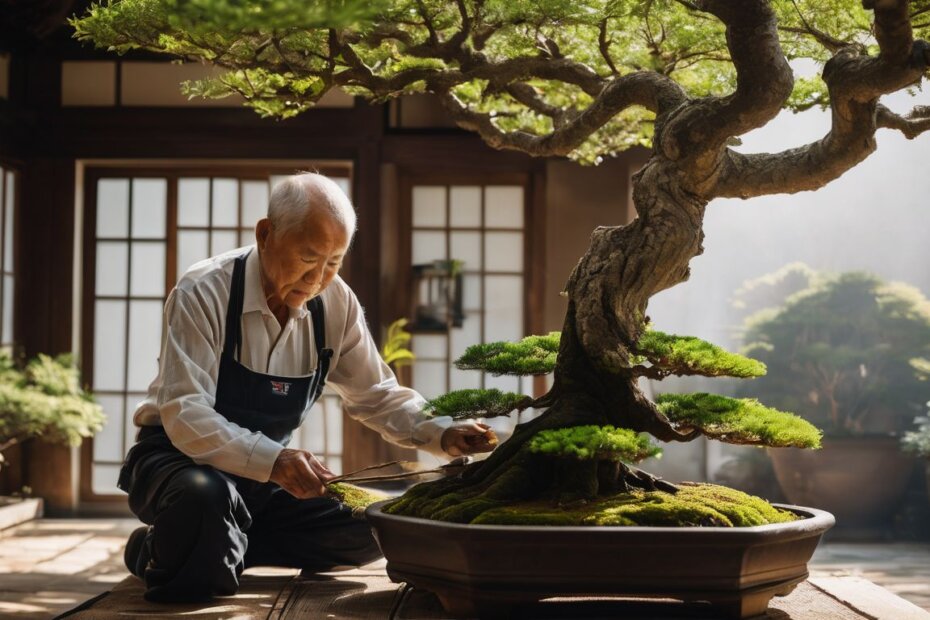Are you fascinated by the serene beauty of bonsai trees but stumble over how to say “bonsai” properly? You’re not alone. Many enthusiasts and gardeners alike find themselves a bit tongue-tied trying to pronounce this Japanese word correctly.
After all, it’s more than just a term; it’s an art form that deserves respect, starting with its name.
Here’s something cool: Bonsai means “planted in a container,” reflecting the practice’s unique blend of horticulture and artistic design. In this blog post, we’ll guide you through the correct pronunciation of “bonsai,” giving you tips to sound like a pro when discussing these miniature wonders.
By reading on, you’ll get closer to understanding not just how to say bonsai but also appreciating what it represents. Let’s grow your confidence one syllable at a time!
Key Takeaways
- The right way to say “bonsai” is “bone – sigh.”
- To get better at saying bonsai, listen to how it’s said online and practice related words like tree, plant, and garden.
- Understand the phonetics of “bone – sigh” to pronounce bonsai correctly and share the art’s beauty.
- Saying “banzai” instead of “bonsai” can confuse others since they sound similar but are different.
- Use resources like audio guides from places like Cambridge English Dictionary to learn pronunciation.
How to Pronounce Bonsai Correctly
The official pronunciation of “Bonsai” is “bone-sigh.” However, other common pronunciations include “baan-zai” and “ban-sigh.”
Baan-zai or Ban-sai?
Some people say “baan-zai” when they try to pronounce bonsai. Others might say “baan-sai”. Both are close but not quite right. It’s important to speak this word correctly, especially if you love these miniature trees or enjoy the art of bonsai.
Say “bone sigh”, not “banzai” like in a cheer. This way, your words will match the beauty and care that go into bonsai gardening. Practice makes perfect! You can learn the correct sounds by listening to audio guides, like the ones on Cambridge English Dictionary online.
Soon, saying bonsai will be as easy as pruning your own dwarf tree!
The official pronunciation
After considering the various pronunciations, it is essential to note that the official pronunciation of bonsai is “bone sigh.” This correct pronunciation aligns with its Japanese origins and reflects the true essence of this botanical art form.
Given that bonsai has become a popular part of global culture, using the correct pronunciation helps maintain respect for its heritage. Incorporating “trees” after bonsai when communicating outside the bonsai community can also aid in understanding.
It’s important to embrace and honor the original pronunciation while sharing knowledge about this captivating Japanese art form.
Other common pronunciations
Some people commonly pronounce bonsai as “baan·zai” or “baan·sai,” which can lead to confusion. The official pronunciation is actually “bone sigh.” However, adding “trees” after bonsai may help those outside the community understand.
It’s important to be aware of these variations in pronunciation when discussing this small-scale form of art and cultivation.
Now, let’s delve into tips for improving your bonsai tree pronunciation.
Tips for Improving Your Bonsai Pronunciation
Listen to audio guides and practice saying related words to improve your bonsai pronunciation. Learning the phonetics of the word can also help in mastering its correct pronunciation.
Listen to audio guides
Improve your bonsai pronunciation by listening to audio guides. This helps you hear the correct way to say “bonsai” and understand its phonetics. You can find audio pronunciations in resources like the Cambridge English Dictionary, aiding your mastery of this small-scale art form rooted in Japanese culture.
Practice saying related words
Listen to how native speakers pronounce words like bonsai, tree, plant, and garden. Repeat these words aloud to practice your pronunciation.
Use the correct phonetics when practicing related words such as “dwarf trees,” “ornamental plants,” “zen gardens,” and “indoor flora.”
Learn the phonetics
To master the correct pronunciation of bonsai trees, it’s essential to understand the phonetics. By grasping the phonetic sounds associated with “bone sigh,” you can confidently articulate this term in conversations about small-scale ornamental trees and Zen gardens.
The emphasis on learning the phonetics is crucial for accurately communicating your passion for bonsai, whether it’s an indoor plant or part of a serene outdoor setting.
Understanding the phonetics elevates your knowledge of pronouncing bonsai correctly, aligning with its cultural significance as a Japanese art form rooted in intricate horticultural practices derived from China’s penjing tradition.
Conclusion
In conclusion, mastering the correct pronunciation of “bonsai” as “bone sigh” is essential. This practical tip can enhance communication about these fascinating miniature trees. Embracing the official pronunciation and practicing related words will lead to a profound impact on your bonsai journey.
Dive into audio guides and learn phonetics to maximize efficiency in improving your bonsai pronunciation. Explore additional resources such as the Cambridge English Dictionary for further learning.
Let’s bring authenticity and precision to our appreciation of the art of bonsai!
FAQs
1. What is the right way to say “bonsai tree”?
To pronounce “bonsai tree” correctly, say it as “bone-sigh tree.” Remember, bonsai trees are small-scale potted plants.
2. Can you break down the word “bonsai” for me?
Sure! Split up “bonsai” into two parts: bone and sigh.
3. Is there a common mistake people make when saying “bonsai”?
Yes, some might mistakenly say “banzai,” which is not correct for these potted plants.
4. Why should I learn to pronounce bonsai properly?
Pronouncing bonsai correctly shows respect for the art of growing these beautiful small trees in pots.
